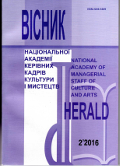SOME ASPECTS OF HISTORICAL GENESIS AND EVOLUTION OF THEATRICAL ACTOR MASK
DOI:
https://doi.org/10.32461/2226-3209.2.2016.138517Keywords:
theater art, mask, disguise, carnival buffoon, scenic character, the grotesqueAbstract
Purpose. The study searches for a scientific approach to understanding of the origin, location and value of the mask in theater art. Some aspects of the use of masks in the theater, since ancient times to the present day are not enough studied in the context of the historical genesis and evolution of the mask. The methodology of the study lies in the appliance of the analytical, logical and systematic approaches for understanding of the theatrical mask phenomenon; comparative historical -- for study of its genesis and evolution and typological for classification of genre diversity. The scientific novelty. The study tries to extend the ideas about the evolution of masks in the theater since ancient times to the present day. It analyses scientific works and summarizes theoretical approaches to the problem of content, roles and functions of the stage mask in a stage-theatrical performance. It systematizes a number of sources on the use of stage mask and reveals genesis and evolution of masks at various cultural and historical stages. Conclusions. Modeling of an image by using a mask is a universal way to create an image in the performing arts. By showing the dynamics of internal and external relationships and meaningful and essential content of the mask (the sacred, aesthetic, domestic, social, historical) we can talk about the evolution of mask as a phenomenon of art.
Downloads
Published
Issue
Section
License
Authors who publish with this journal agree to the following terms:
1. Authors retain copyright and grant the journal right of first publication with the work simultaneously licensed under a Creative Commons Attribution License International CC-BY that allows others to share the work with an acknowledgement of the work's authorship and initial publication in this journal.
2. Authors are able to enter into separate, additional contractual arrangements for the non-exclusive distribution of the journal's published version of the work (e.g., post it to an institutional repository or publish it in a book), with an acknowledgement of its initial publication in this journal.
3. Authors are permitted and encouraged to post their work online (e.g., in institutional repositories or on their website) prior to and during the submission process, as it can lead to productive exchanges, as well as earlier and greater citation of published work (See The Effect of Open Access).


